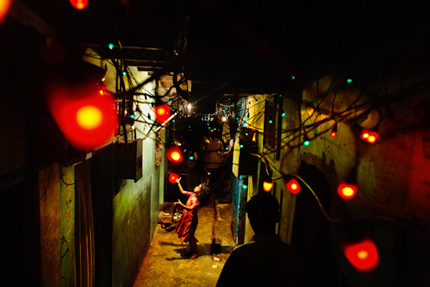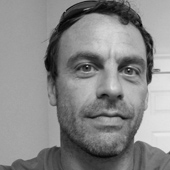
India, Mumbai, 2006. A little girl playing in Laxmi Chawl, a neighborhood of Dharavi.
Several years ago, paternity got the Oslo-based photographer Jonas Bendiksen thinking about slums. Between the time his father was born and the time his son came along in 2002, the world’s population more than doubled, to 6.5 billion. When, or if, Bendiksen has a grandchild, he says, the count will have tripled to 8 billion. Most of these people are gravitating toward cities; in 2008 for the first time, the United Nations estimates, more people lived in the world’s cities than in rural places. It came to Bendiksen’s attention that the neighborhoods growing fastest are slums, which an estimated 1 billion people now call home. “That 1 billion is predicted to double over the next couple of decades,” he says. “The slums will essentially become the norm in human habitation rather than the exception.”
Bendiksen, a 32-year-old Magnum photographer who has worked for National Geographic, Newsweek, Time and The New York Times’s Sunday magazine, decided to see what this urban future may hold by living in several slums himself. He started in the district known as Kibera, which packs a million people, by some counts, into part of Nairobi. His first visit lasted five weeks, and throughout that time, he says, he rarely left the area.
Since then, he’s lived for weeks or months in the slums of Mumbai, Jakarta and Caracas, getting to know the inhabitants. A new exhibition of photos that came from these experiences, "The Places We Live," opened recently at the National Building Museum, in Washington, D.C. (See accompanying slide show.) Bendiksen's slum photos also are collected in a book published by Aperture under the same title, with an introduction by Philip Gourevitch.
In the exhibition, Bendiksen’s images project at life size onto four walls of separate, slum-sized enclosures, depositing you into more than a dozen households and amid landscapes of raw persistence. Stories of the people he came to know play in voiceover while you look around the rooms, streets and panoramas he’s captured with gripping clarity. “I like to keep things neat,” says Asanah, a mother of three kids in a Jakarta kampung. “Even though we live underneath a bridge, I still like us to have some decorations.” Her husband built their room in two days and papered the walls with yellow stickers for Dunlop tires.
After seeing the Building Museum show and leaving a bit dazed, I emailed several questions to Bendiksen about his work. Here is what he had to say:
Bradford McKee
How did you first begin this project?
Jonas Bendiksen
I realized there is no better way to imagine what the future world looks like for my son without getting to know the slums better. It’s essential that we understand more about what these places are and who lives there.
Once I decided I wanted to talk about this issue, I contacted a young guy I knew who lived in the slum of Kibera, outside of Nairobi, Kenya. I proposed to him that we work together. He invited me there, and with his help, I rented a small room in the middle of the slum.
It was fascinating. I’d worked in Nairobi before on other projects and had visited briefly in Kibera. But it was a very different experience to immerse myself there. I was not prepared for the intricacies and wide range of stories within these slums. I think in the West, we easily typecast these areas as monolithic dens of poverty, crime, misery and destitution. These things obviously exist in the slums in vast numbers. But I quickly came to learn that they are much more than that. The great majority of slum dwellers do manage to squeeze out normalcy despite truly difficult conditions. I was both extremely humbled and inspired by that.
Kibera is a huge slum and has enormous issues in terms of sanitation, population density and extreme poverty. The very first room I photographed there belonged to a young couple named Andrew and Ann. It was a tiny room densely furnished with secondhand couches and a small kitchen. I took my pictures and got my audio recorder out. To my surprise, Andrew didn’t talk much about all the problems around them — the garbage outside his door, the overflowing sewer or lack of jobs. What he wanted to talk about was…interior design. About how much work he had put into his room, how they’d taken care to make it as nice a home as they possibly could.
For me it was a huge eye-opener. I realized that of course 1 billion slum dwellers can’t go through every day of their lives just thinking about how horrible everything is. It’s human nature to try to create a dignified daily life out of any situation. This really inspired me to go beyond Kibera to other slums. I decided to make "The Places We Live" a quest, not for the negative extremes of the slums but for how people create value and dignity out of the most difficult situations. If I learned one thing, it is that the gamut of experience, social status and worldview is just as large inside each of these slums as it is in New York or London.
McKee
When you land in these place, where do you live? How do you meet the families you portray?
Bendiksen
People often ask me that, thinking of these slums as pretty hostile places. The truth is, I’ve never worked on a photographic project where access has been so easy.
I spent a great deal of time in each of these communities, and the residents understood that I wasn’t there just to get a few great shots. I think people picked up that I wasn’t hunting for spots that would make their neighborhoods look as extreme as possible — the worst gangs, the biggest garbage dumps, the worst sanitation. I was looking for what anyone in London or Seattle would recognize as normalcy, as daily life.
Secondly, I think people reacted to the fact that this was an interactive project. Photographing one house and doing the audio recordings could often take a whole day. We’d sit and talk and wait for all the residents to come home: Jyoti was in school. Manoj was out working until 4 p.m., etc. We’d have to gather the whole family before we could take the panoramic interior images. Then it would be done in four images, first with two residents against one wall; then the rest of the family would step out to make room. Then we’d switch, and a few other family members would pose against the next wall, and the others would step outside. It took a lot of time and was very participatory.
Inevitably, once I was done, some of the neighbors would grab me and say: “You think that’s a story? Come to my house. I’ve got a better one. See what I’ve built.”
McKee
Kibera is said to have started after World War I as a way to house returning Nubian soldiers. What did you learn about the ways slums begin?
Bendiksen
There are myriad reasons for slum formation, as these types of informal settlements spring up in a vast variety of countries and cities about the globe — and it doesn’t necessarily happen in the same way in each place. They can be a product of relocation by municipalities, or newly arrived settlers building on land with unclear ownership on the outskirts of a metropolis. In other cases, such as Dharavi in Mumbai, the current slum settlement actually predates the city itself. Dharavi was a rural village that was gradually swallowed into a rapidly expanding Mumbai. Now it lies smack in the center of the city.
Every week, almost 1.5 million people move from rural areas to cities around the planet, and slums are a natural first step for many of these migrants. On a global scale, we are simply not prepared for this massive urban migration.
McKee
Many places in the slums look structurally quite layered, like urban palimpsests. Did you often find signs of renewal and repair?
Bendiksen
Slums are in a constant state of transformation. Parts are always being added, modified or torn down by the authorities and then built back up again.
McKee
Slums, as you have noted, are dense. Why?
Bendiksen
I think it’s a combination of the pressures of a very drastic rate of urbanization, combined with limited space. In economic terms, slum dwellers will want to be close to opportunities in the formal parts of the city — jobs, transactions, goods. Slums form on otherwise vacant land or land with unclear tenure or ownership. Such spaces are, by definition, rare, so people group together in the few spaces there are. Also I think it has to do with security, to stay together in a tight community. There is a certain safety in numbers. (Overall, though, I think it’s important to say that I am in no way an authority on urbanism per se.)
McKee
How are slum houses like other forms of real estate. Are there titles or deeds? Landlords or rent?
Bendiksen
This differs from slum to slum. In general, even if the land the slum was built on technically was owned by the municipality or private landowners, someone was always charging rent. Landlords, connected to the power brokers within each slum, would demand payment from residents, even if the land clearly did not belong to the person collecting the money. The slums are not free-for-alls. People who want to move into a well-established slum must get permission from the local strongman.
Some find it surprising that even in the slums there is quite a bit of money moving around. And there are always some who get rich, in relative terms at least.


Comments [6]
Firstly i would like to thank you for this article here and most importantly to Jonas for his honest purpose in the project and the way he has gone about documenting and finding aspect of modern urban living spaces with these slums becoming an important part of almost every urban space in the developing countries. The idea of showing how normal life can be or to show life in a positive way in these slums is very welcoming. We keep coming across such similar attempts on documenting such spaces that invariably end up showing pain and destitution all the time which does not necessarily have to be the case. I really wish i could get to see this exhibition. I shall keep my antennas on. :)
Cheers
09.30.09
03:41
09.30.09
04:21
Ta
09.30.09
12:21
10.01.09
03:47
10.05.09
12:43
e- marketing
04.25.11
02:39